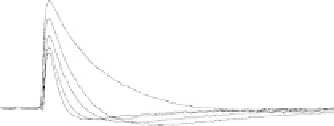Biomedical Engineering Reference
In-Depth Information
400
15
300
10
200
100
5
0
−
100
0
0
50
100
150
0.5
1.0
1.5
2.0
2.5
3.0
Concentration of Fe(CN)
4
−
in acceptor side (mM)
6
(A)
Time (
s)
(B)
µ
FIGURE 15.3
The effect of varying the aqueous redox compositions on the time course of the AC photosignal from the Mg por-
phyrin BLM. (A) The reductant side was free of electron acceptors and donors. The oxidant side initially con-
tained 10 mM of potassium ferricyanide but no ferrocyanide. The concentration of potassium ferrocyanide was
then increased from 0 to 0.5, 1.0, 2.0, and finally to 3.0 mM. The relaxation of the photocurrent became progres-
sively faster and faster. (B) Deconvolution yields the pseudofirst-order rate constant of the interfacial charge
recombination, 1/
p
, which is plotted against the concentration of Fe(CN)
6
4
. This plot yields a straight line pass-
ing through the origin, as expected from a pseudofirst-order regime. The slope is the second-order rate constant
of the reverse electron transfer at the oxidant interface (4.3
10
7
M
1
s
1
. (From Hong, F. T. (1976). Charge
transfer across pigmented bilayer lipid membrane and its interfaces.
Photochem. Photobiol.
24:155-189.)
0.5)
subsequently the current reverses its polarity (Figure 15.2). If the concentration of ferro-
cyanide at the oxidant side is increased, the decay rate of the photocurrent (i.e., the relax-
ation of the photoelectric process) also increases (Figure 15.3A). This observation suggests
that increasing ferrocyanide (electron donor) concentration at the oxidant side enhances
the rate of the reverse (back) electron transfer. Furthermore, the relaxation-time course of
the photocurrent can be fit with the following equations [35]:
t
t
It
()
A
exp
A
exp
(15.1)
s
l
s
l
where the amplitudes and the time constants are inversely related:
A
A
s
l
(15.2)
l
s
Equations (15.1) and (15.2) guarantee that the photocurrent obeys the following
condition:
(15.3)
∫
It
d0
t
()
0
which happens to be the
zero time-integral
condition discovered by Hagins and
McGaughy [31]. Together with the ferrocyanide dependence of the photosignal relax-
ation, the zero time-integral condition suggests that the transient photocurrent in the Mg
porphyrin membrane is a manifestation of forward and reverse electron transfers at the
oxidant interface. It is not caused by the reversal of transmembrane diffusion of P and
P
+
because the latter is much too slow. Nor is it caused by interfacial electron transfer at
the reductant interface because the AC photosignal is insensitive to the redox composi-
tion there (the AC signal generated at the reductant side is much smaller; see [35,40]). In





